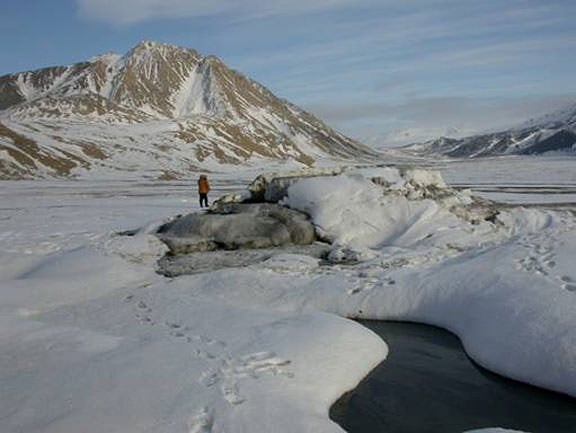[/caption]
The discovery of methane-eating bacteria in a very unique region of Canada's extreme north supports the theory that similar organisms could be on Mars. Researchers have found methane-eating bacteria in a cold, methane filled spring located on Axel Heiberg Island in Canada, and say the spring is similar to possible past or present springs on Mars, and that therefore they too could support life.
The spring, called Lost Hammer supports microbial life. It is so salty that it doesn't freeze despite the cold, and it has no consumable oxygen in it, said Dr. Lyle Whyte from McGill University in Montreal. There are, however, big bubbles of methane that come to the surface, which made the research team – which also included scientists from National Research Council of Canada, the University of Toronto and the SETI Institute –curious as to whether the gas was being produced geologically or biologically and whether anything could survive in this extreme hypersaline subzero environment.
"We were surprised that we did not find methanogenic bacteria that produce methane at Lost Hammer," Whyte said, "but we did find other very unique anaerobic organisms - organisms that survive by essentially eating methane and probably breathing sulfate instead of oxygen."
The discoveries of methane and frozen water on Mars, along with recently formed gullies are similar to what is occurring on Axel Heiberg Island. The methane on Mars is quite intriguing since the short-lived gas is obviously being replenished in some way.
But just the fact that methane is on Mars could mean the planet could support life.
"The point of the research is that it doesn't matter where the methane is coming from," Whyte explained. "If you have a situation where you have very cold salty water, it could potentially support a microbial community, even in that extreme harsh environment."
The Lost Hammer spring region is very analogous to Mars. "There are places on Mars where the temperature reaches relatively warm -10 to 0 degrees and perhaps even above 0 degrees C," Whyte said, "and on Axel Heiberg it gets down to -50, easy. The Lost Hammer spring is the most extreme subzero and salty environment we've found. This site also provides a model of how a methane seep could form in a frozen world like Mars, providing a potential mechanism for the recently discovered Martian methane plumes."
Source:
McGill University
 Universe Today
Universe Today
